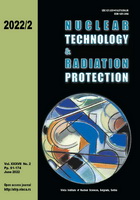
EVALUATION OF RADIATION HAZARDS AND RISK ASSESSMENT IN AGRICULTURAL SOIL AND COMMONLY CONSUMED VEGETABLES IN THE DISTRICT OF KLANG, MALAYSIA
Pages: 145-152
Authors: Hariandra Muthu, Ramesh Kasi, Ramesh T. Subramaniam, and Shahid BashirAbstract
Commonly consumed vegetables and their surrounding soil samples are gathered from a farm located in Klang, Selangor. Gamma spectrometry has been utilized to analyze the activity concentration of the natural radionuclides, 226Ra, 232Th, and 40K in nine vegetables and soil samples collected. These data are used to evaluate the hazard indices in the soil samples and their radiological exposure to humans. It is found that the external hazard index Hex ranged from 0.05 to 0.44 with a mean value of 0.14. The internal hazard index Hin of the soil samples ranged from 0.05 to 0.56 with a mean value of 0.17. Both Hex and Hin average values are lower than the limit established by the European Commission for Radiation Protection. The absorbed dose rate Dn, The annual ingestion dose Aeff, annual effective dose equivalent AEDE, and excess life-time cancer risk, are used to learn the potential risk on the general public consuming these vegetables. For the vegetable sample, it is found that the average value for the Dn is 6.70 nGyh-1 and ranged between 1.75 to 16.94 nGyh-1. The average value of Aeff is 10.17 µSv, and it ranges from 2.54 µSv to 22.89 µSv. The range of AEDE is between 2.15 µSv and 20.78 µS, with an average value of 8.21 µSv. Excess life-time cancer risk ELCR is used to determine the likelihood of cancer development due to the radiological exposure of consuming these vegetables. It is found that the average value of ELCR is 2.87·10-5, and the range is from 0.75·10-5 to 7.27·10-5. Both the Aeff and AEDE are found to be lower than the average world value recommended by UNSCEAR.
Key words: annual ingestion dose, radiation hazard, naturally occurring radionuclide, hazard index, absorbed dose rate
FULL PAPER IN PDF FORMAT (520 KB)
